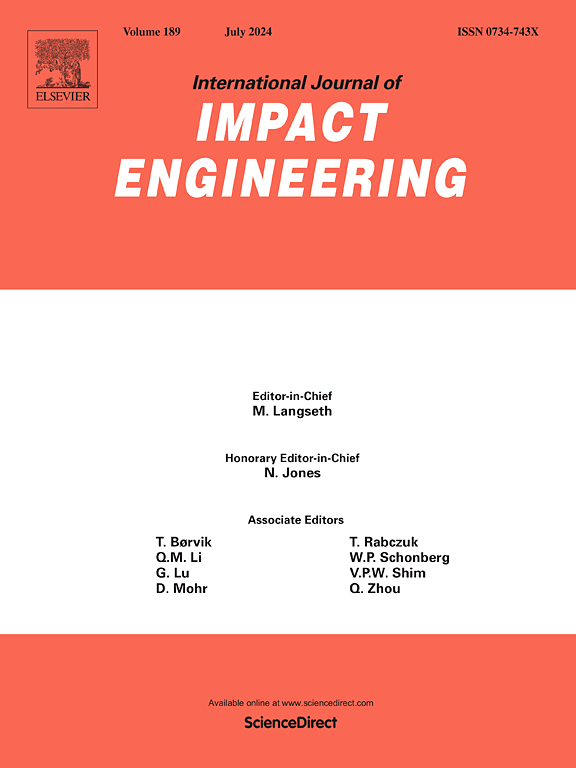Dynamic tensile behaviors and crack propagation in fiber-reinforced cementitious composites: Experimental investigation and peridynamic simulation
IF 5.1
2区 工程技术
Q1 ENGINEERING, MECHANICAL
International Journal of Impact Engineering
Pub Date : 2024-11-06
DOI:10.1016/j.ijimpeng.2024.105161
引用次数: 0
Abstract
Fiber-Reinforced Cementitious Composites (FRCC) have gained significant attention in engineering applications due to their superior mechanical properties and toughness, particularly under high strain rate conditions. This study performed dynamic tensile tests on FRCC at high strain rates (35–110 s⁻¹) using a Split Hopkinson Tensile Bar (SHTB) apparatus. Additionally, a novel Peridynamic (PD) model was developed for the SHTB and FRCC system, leveraging the advanced capabilities of the emerging PD theory. The study compared and analyzed dynamic tensile strength, ultimate tensile strain, strain rate effects, failure modes, and crack development in FRCC with different fiber ratios at various high strain rates, using both experimental data and PD simulations. The results show that the PD-SHTB-FRCC dynamic model developed in this study exhibits high consistency between numerical simulations and experimental findings, effectively capturing the processes of crack initiation, propagation, and complete failure in FRCC specimens. The dynamic tensile properties of FRCC improve significantly with increased strain rates, with polyethylene (PE) fibers providing superior reinforcement compared to steel fibers. Notably, the dynamic tensile strength, peak tensile stress, and ultimate tensile strain of FRCC increase significantly with rising strain rates, with specimens containing higher PE fiber content showing a more pronounced enhancement effect. For strain rates between 42.6 s⁻¹ and 76.1 s⁻¹, considering dynamic tensile strength, ultimate tensile strain, and peak tensile stress, the optimal combination for resisting dynamic tensile loads was 1.5 % PE fibers and 0.5 % steel fibers. At a strain rate of 99.8 s⁻¹, a 2 % PE fiber ratio alone provided the best performance.
纤维增强水泥基复合材料的动态拉伸行为和裂纹扩展:实验研究与周动态模拟
纤维增强水泥基复合材料(FRCC)因其卓越的机械性能和韧性,尤其是在高应变率条件下的机械性能和韧性,在工程应用中获得了极大的关注。本研究使用分体式霍普金森拉伸棒(SHTB)设备对 FRCC 进行了高应变率(35-110 s-¹)动态拉伸试验。此外,还为 SHTB 和 FRCC 系统开发了一个新颖的周动力 (PD) 模型,充分利用了新兴 PD 理论的先进功能。研究利用实验数据和 PD 模拟,比较和分析了不同纤维比的 FRCC 在各种高应变速率下的动态拉伸强度、极限拉伸应变、应变速率效应、破坏模式和裂纹发展。结果表明,本研究开发的 PD-SHTB-FRCC 动态模型在数值模拟和实验结果之间表现出高度的一致性,能有效捕捉 FRCC 试样中裂纹的产生、扩展和完全破坏的过程。随着应变速率的增加,FRCC 的动态拉伸性能显著提高,与钢纤维相比,聚乙烯(PE)纤维具有更优越的加固性能。值得注意的是,FRCC 的动态拉伸强度、峰值拉伸应力和极限拉伸应变随着应变速率的增加而显著增加,其中聚乙烯纤维含量较高的试样显示出更明显的增强效果。应变速率在 42.6 s-¹ 和 76.1 s-¹ 之间时,考虑到动态拉伸强度、极限拉伸应变和峰值拉伸应力,抵抗动态拉伸载荷的最佳组合是 1.5 % 聚乙烯纤维和 0.5 % 钢纤维。在应变速率为 99.8 s-¹ 时,仅 2 % 的聚乙烯纤维比例就能提供最佳性能。
本文章由计算机程序翻译,如有差异,请以英文原文为准。
求助全文
约1分钟内获得全文
求助全文
来源期刊

International Journal of Impact Engineering
工程技术-工程:机械
CiteScore
8.70
自引率
13.70%
发文量
241
审稿时长
52 days
期刊介绍:
The International Journal of Impact Engineering, established in 1983 publishes original research findings related to the response of structures, components and materials subjected to impact, blast and high-rate loading. Areas relevant to the journal encompass the following general topics and those associated with them:
-Behaviour and failure of structures and materials under impact and blast loading
-Systems for protection and absorption of impact and blast loading
-Terminal ballistics
-Dynamic behaviour and failure of materials including plasticity and fracture
-Stress waves
-Structural crashworthiness
-High-rate mechanical and forming processes
-Impact, blast and high-rate loading/measurement techniques and their applications
 求助内容:
求助内容: 应助结果提醒方式:
应助结果提醒方式:


